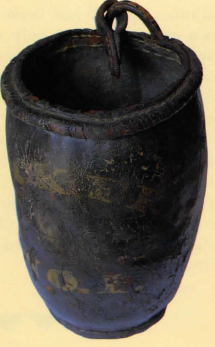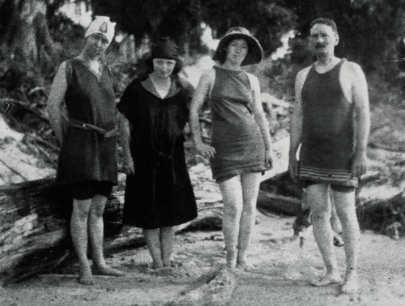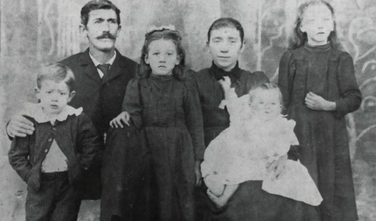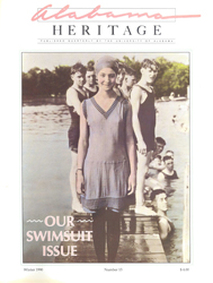|
On the cover: An unidentified beauty captures attention at East Lake Park, Birmingham, c. 1922. (Courtesy Birmingham Public Library. Tinting by Laura Woelfel-Madison)
|
FEATURE ABSTRACTS
 Leather Bucket. (Photographed by G. LaMar Hubbs)
Leather Bucket. (Photographed by G. LaMar Hubbs)
Mobile's Antebellum Volunteer Firemen
By C.A. Spencer, Jr.
In 1818 the small town of Mobile imported from Boston its first fire engine, a small, hand-powered pumper, which was pulled by the firemen to the site of the fire. Firefighting itself remained largely unorganized until 1819, when the first volunteer fire company in Mobile was organized by a former Spanish colonist, Jean Baptiste Tregnier. Soon there were many volunteer fire companies, all competing with each other. This article gives the story of these groups, of the many fires to ravage Mobile, and of Mobile's place in the development of urban centers in Alabama.
Additional Information
About the Author
C. A. Spencer, Jr., Associate Professor of Insurance in the University of Alabama's College of Commerce and Business Administration, has long been interested in the history of insurance in Alabama and the South. He has published articles on health insurance and health care delivery systems in antebellum Alabama, on the evolution of Southern benevolent societies, and on the development of black insurance companies in nineteenth-century Alabama.
The editors wish to thank Mel Cosgrove, Mobile Fire Department; William Langston, Shelton State Fire College; and Roy L. Matt, Jr., Alabama Association of Volunteer Fire Departments, for assistance in producing this article.
By C.A. Spencer, Jr.
In 1818 the small town of Mobile imported from Boston its first fire engine, a small, hand-powered pumper, which was pulled by the firemen to the site of the fire. Firefighting itself remained largely unorganized until 1819, when the first volunteer fire company in Mobile was organized by a former Spanish colonist, Jean Baptiste Tregnier. Soon there were many volunteer fire companies, all competing with each other. This article gives the story of these groups, of the many fires to ravage Mobile, and of Mobile's place in the development of urban centers in Alabama.
Additional Information
- Amos, Harriet E. Cotton City: Urban Development in Antebellum Mobile (University of Alabama Press, 1985).
- Bainbridge, John. Biography of an Idea: The Story of Mutual Fire and Casualty Insurance (Doubleday, 1952) .
- Cosgrove, J. M. City of Mobile Fire Department Centennial, 1988 (Mobile Fire Department, 1988).
- Craighead, Erwin. Craighead's Mobile, edited by Caldwell Delaney (The Haunted Bookshop, 1968).
- Dana, David D. The Fireman: The Fire Departments of the United States with a Full Account of All Large Fires, Statistics of Losses and Expenses, Theatres Destroyed by Fire and Accidents, Anecdotes, and Incidents (James French and Company, 1858).
- Delaney, Caldwell. The Phoenix Volunteer Fire Company of Mobile, 1838-1888 (The Phoenix Museum, 1967).
- Price, Thomas F. Chief of Fire Department, and C. W. Soost, Chief of Police Department. Souvenir History of the Mobile Fire Department (Commercial Printing Company, 1902).
About the Author
C. A. Spencer, Jr., Associate Professor of Insurance in the University of Alabama's College of Commerce and Business Administration, has long been interested in the history of insurance in Alabama and the South. He has published articles on health insurance and health care delivery systems in antebellum Alabama, on the evolution of Southern benevolent societies, and on the development of black insurance companies in nineteenth-century Alabama.
The editors wish to thank Mel Cosgrove, Mobile Fire Department; William Langston, Shelton State Fire College; and Roy L. Matt, Jr., Alabama Association of Volunteer Fire Departments, for assistance in producing this article.
 E.A. Enderle and three of his six daughters, 1920, in front of the Enderle summer home on the eastern shore of Mobile Bay, between Fairhope and Battle's Wharf, Alabama
E.A. Enderle and three of his six daughters, 1920, in front of the Enderle summer home on the eastern shore of Mobile Bay, between Fairhope and Battle's Wharf, Alabama
Alabama Takes the Plunge!
Swimsuits from Alabama's Past
By the Editors
The swimsuit is a relatively modern invention. Previous generations had no need for such garments, either because they swam nude (the Romans) or not at all (medieval Europeans). It was not until the Victorian era that people decided--in order to preserve modesty--to bathe in layered costumes of heavy wool or silk. As time passed, these garments became simpler, smaller, and more streamlined. In the short history of the swimsuit, these garments have undergone dramatic changes, none more dramatic than those of the first half of the twentieth century. During this remarkable era, Alabama swimmers kept pace with the times--and they documented it. This special photographic essay charts the evolution of the swimsuit in Alabama.
Additional Information
About the Author
We decided to take a whimsical look at swimsuits on Alabama beaches over the first half of the twentieth century. After all, we thought, why should Sports Illustrated have all the swimsuit fun? Putting this section together was indeed a pleasure, and it was accomplished with the help of a number of our readers who were generous enough to send us their family photographs. We think of this as a one-time-only swimsuit issue, but who knows? Should another cache of great swimsuit photographs come our way, we could be persuaded to do it again. Check your attic for old photographs. Your greatgrandmother could be a cover girl yet.
We are grateful to Virginia Van de Veer Hamilton, Anne V. Patchem, Mildred Moore McCrimmon Crain, and G. Ward Hubbs for contributing family photographs, and to student interns Brooks Gresham and Susan Overbey for research assistance.
Swimsuits from Alabama's Past
By the Editors
The swimsuit is a relatively modern invention. Previous generations had no need for such garments, either because they swam nude (the Romans) or not at all (medieval Europeans). It was not until the Victorian era that people decided--in order to preserve modesty--to bathe in layered costumes of heavy wool or silk. As time passed, these garments became simpler, smaller, and more streamlined. In the short history of the swimsuit, these garments have undergone dramatic changes, none more dramatic than those of the first half of the twentieth century. During this remarkable era, Alabama swimmers kept pace with the times--and they documented it. This special photographic essay charts the evolution of the swimsuit in Alabama.
Additional Information
- Bigelow, Marybelle S. Fashion in History: Apparel in the Western World (Burgess Publishing Co., 1970).
- Cohn, David L. Good Old Days (Simon and Schuster, 1940).
- O'Hara, Georgina. The Encyclopedia of Fashion: From 1840 to the 1980s (Thames and Hudson, 1986).
- Johnson, William Oscar. "In the Swim," Sports Illustrated, 70 (February 1989) 6: 30-34.
- Probert, Christina, ed., Swimwear in Vogue Since 1910 (Abbeville Press, 1981).
About the Author
We decided to take a whimsical look at swimsuits on Alabama beaches over the first half of the twentieth century. After all, we thought, why should Sports Illustrated have all the swimsuit fun? Putting this section together was indeed a pleasure, and it was accomplished with the help of a number of our readers who were generous enough to send us their family photographs. We think of this as a one-time-only swimsuit issue, but who knows? Should another cache of great swimsuit photographs come our way, we could be persuaded to do it again. Check your attic for old photographs. Your greatgrandmother could be a cover girl yet.
We are grateful to Virginia Van de Veer Hamilton, Anne V. Patchem, Mildred Moore McCrimmon Crain, and G. Ward Hubbs for contributing family photographs, and to student interns Brooks Gresham and Susan Overbey for research assistance.
 Henry B. Wood's son, William Henry, known as Henry as an adult, posed with his family c. 1900.
Henry B. Wood's son, William Henry, known as Henry as an adult, posed with his family c. 1900.
From Montgomery to Gettysburg: War Letters from Alabama Soldier Henry B. Wood
By Wayne Wood
Wayne Wood tells the story of his great-great-grandfather's experiences in the Civil War through the letters Henry Wood sent home to his family. Although lacking a formal education, Wood was a keen observer of the events taking place around him, and his letters home offer an evocative first-hand account of the life of a Confederate foot soldier in Robert E. Lee's Army of Northern Virginia. In his correspondence, Wood relates his own trials during some of the bloodiest battles of the war.
Additional Information
About the Author
In 1967, when Wayne Wood was in the seventh grade, he read his great-great-grandfather's letters for the first time. Too young to understand their importance, he put them back in the box where his great-great-grandmother had stored them after her husband's death in 1863. Years later, Wood took them out again and began to research the people and events mentioned in the letters. He visited Marble Valley in Coosa County, searched out graveyards in the area, and bit by bit reconstructed his family's past. "Genealogy is a kind of disease," he says. "Once you get started it's hard to stop." For Wood, a graduate of Mobile College who coaches football, track, and basketball at Simmons Middle School in Birmingham, the experience has been very rewarding. "I've met people across the country," he says, "who find Henry Wood's letters fascinating and who now are interested in learning more about their own past."
By Wayne Wood
Wayne Wood tells the story of his great-great-grandfather's experiences in the Civil War through the letters Henry Wood sent home to his family. Although lacking a formal education, Wood was a keen observer of the events taking place around him, and his letters home offer an evocative first-hand account of the life of a Confederate foot soldier in Robert E. Lee's Army of Northern Virginia. In his correspondence, Wood relates his own trials during some of the bloodiest battles of the war.
Additional Information
- Catton, Bruce. Gettysburg: The Final Fury (Doubleday & Company, 1974).
- Commager, Henry Steele. The Blue and The Gray: The Story of the Civil War as Told by Participants (Dobbs-Merrill, 1950; reprinted ed., Fairfax Press, 1982).
- Foote, Shelby. The Civil War, A Narrative, 3 vols. (Random House, 1958-1974).
- Handy, Isaac W. K. United States Bonds; or Duress by Federal Authority: A Journal of Current Events during an Imprisonment of Fifteen Months, at Fort Delaware (Turnbull Brother, 1874).
- Mitchell, Reid. Civil War Soldiers: Their Expectations and Their Experiences (Viking, 1988).
- Park, Robert Emory. Sketch of the Twelfth Alabama Infantry, reprinted from Southern Historical Society Papers, Volume XXXllI (William Ellis Jones, Printer, 1906).
- Robertson, James I., Jr. Soldiers Blue and Gray (University of South Carolina Press, 1988).
- Wiley, Bell Irvin. The Life of Johnny Reb: The Common Soldier of the Confederacy (Louisiana State University Press, 1943 and 1978).
- Wood, Wayne. The Marble Valley Boys (privately printed, 1986).
About the Author
In 1967, when Wayne Wood was in the seventh grade, he read his great-great-grandfather's letters for the first time. Too young to understand their importance, he put them back in the box where his great-great-grandmother had stored them after her husband's death in 1863. Years later, Wood took them out again and began to research the people and events mentioned in the letters. He visited Marble Valley in Coosa County, searched out graveyards in the area, and bit by bit reconstructed his family's past. "Genealogy is a kind of disease," he says. "Once you get started it's hard to stop." For Wood, a graduate of Mobile College who coaches football, track, and basketball at Simmons Middle School in Birmingham, the experience has been very rewarding. "I've met people across the country," he says, "who find Henry Wood's letters fascinating and who now are interested in learning more about their own past."
